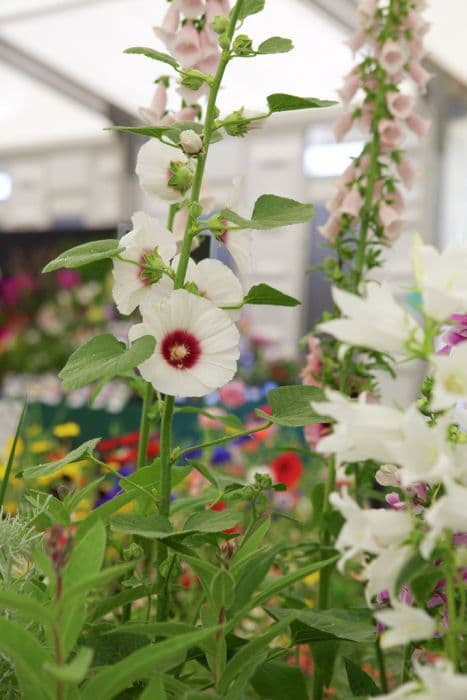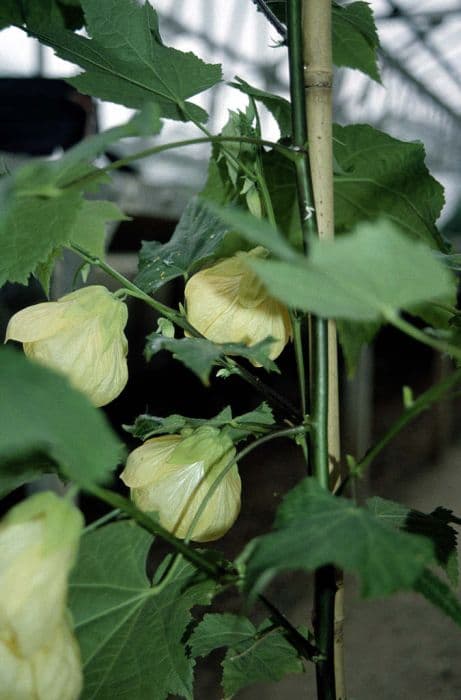Hollyhock Alcea rosea 'Halo White' (Halo Series)

ABOUT
Alcea rosea 'Halo White', commonly known as the hollyhock, is a popular flowering plant known for its striking blooms. This variety, part of the Halo Series, boasts large, white flowers that stand out with a bold, contrasting central halo that is usually a vibrant shade, often a bright yellow or lemon hue. The flowers are arranged on tall, erect stalks, blooming sequentially from the bottom upwards, opening into a classic, open funnel shape which gives them an old-world charm. The hollyhock's foliage is made up of lobed leaves, rough to the touch, with a heart-shaped base. The leaves are a deep green color, offering a lush backdrop to the standout blooms. The overall appearance of the 'Halo White' hollyhock is one of classic garden elegance, serving as a magnet for both the eyes and pollinators like bees, butterflies, and hummingbirds. Its stately flowers, which emerge in the peak of summer, maintain their impressive display well into the fall, adding prolonged interest to any garden setting.
About this plant
 Names
NamesFamily
Malvaceae
Synonyms
Hollyhock, Halo White Hollyhock, Halo Series Hollyhock
Common names
Alcea rosea 'Halo White'
 Toxicity
ToxicityTo humans
The most common common name for Alcea rosea 'Halo White' is hollyhock. Hollyhocks are generally not considered toxic to humans. They do not contain significant quantities of compounds known to cause poisoning in humans, and there is limited information regarding their toxicity. Therefore, typical ingestion of parts of this plant is not expected to cause severe symptoms. However, as with any non-food plant, consumption is not advised, and sensitive individuals may experience mild stomach upset if ingested.
To pets
The most common common name for Alcea rosea 'Halo White' is hollyhock. Hollyhocks are not known to be toxic to pets such as cats and dogs. They are not listed on the toxic plant lists maintained by major animal welfare organizations such as the ASPCA. Therefore, ingestion of hollyhocks by pets is unlikely to cause poisoning. However, as with any non-food plant, pet owners should prevent their animals from eating large amounts of any plant material, which could potentially lead to gastrointestinal discomfort or obstruction.
 Characteristics
CharacteristicsLife cycle
Biennials
Foliage type
Deciduous
Color of leaves
Green
Flower color
White
Height
5-6 feet (1.5-1.8 meters)
Spread
2 feet (0.6 meters)
Plant type
Herb
Hardiness zones
3-9
Native area
Asia Europe
Benefits
 General Benefits
General Benefits- Attracts Pollinators: This plant is attractive to bees, butterflies, and birds, which helps in pollination and supports biodiversity.
- Aesthetic Appeal: Alcea rosea 'Halo White' has beautiful large white flowers with a dark center, adding charm to gardens.
- Tall Vertical Accent: The plant grows to a height of up to 6-8 feet, providing a striking vertical element in landscape design.
- Cottage Garden Style: Ideal for cottage gardens, its blooms contribute to the classic, informal garden look many desire.
- Easy to Grow: It is relatively easy to cultivate in a variety of soil types, though it prefers well-drained soil and full sun.
- Perennial Growth: As a perennial, it returns each year, saving the cost and effort of replanting annually.
- Drought Tolerance: Once established, it is moderately tolerant of drought, reducing the need for frequent watering under the right conditions.
- Cut Flowers: The flowers are suitable for cutting, making them a lovely addition to fresh floral arrangements.
- Wildlife Habitat: Provides shelter and food for wildlife, playing a role in the ecological health of a garden ecosystem.
- Privacy Screen: Its height can potentially be used to create a natural privacy screen in garden spaces.
 Medical Properties
Medical Properties- There is no well-documented evidence that Alcea rosea 'Halo White' (commonly known as Hollyhock) is used for medical purposes.
 Air-purifying Qualities
Air-purifying QualitiesThis plant is not specifically known for air purifying qualities.
 Other Uses
Other Uses- Dye Production: The petals of the hollyhock can be used to make a natural dye, which can color fabrics and handicrafts in shades of pale yellow to green.
- Livestock Feed: In some regions, the leaves of hollyhocks are used as a feed for livestock, although it is not a common practice.
- Companion Planting: Hollyhocks can serve in companion planting by attracting pollinators that are beneficial to nearby fruit and vegetable crops.
- Erosion Control: The deep roots of hollyhocks can help in stabilizing the soil, making it a potential plant for erosion control in some landscapes.
- Biodegradable Cups: Hollowed hollyhock stems have been traditionally used as containers or cups for holding small items or even as a form of disposable tablewares in rustic settings.
- Natural Mulch: Once the plant has died back, the remaining biomass can be used as a natural mulch to enrich the soil and suppress weeds in garden beds.
- Culinary Garnish: While not commonly known for their edibility, the flowers can be used as a decorative and potentially edible garnish on salads and desserts.
- Paper Making: The fibers from hollyhock stems can be incorporated into homemade paper making processes, offering texture and interest to the finished product.
- Photographic Imagery: The unique form and color of hollyhock flowers can be used in a technique called 'flower pounding' to create natural imprints on fabric or paper for artistic projects.
- Floral Jewelry: The individual hollyhock petals can be used to make delicate floral jewelry, such as earrings or pendants, when preserved in resin or other mediums.
Interesting Facts
 Feng Shui
Feng ShuiThe Hollyhock is not used in Feng Shui practice.
 Zodiac Sign Compitability
Zodiac Sign CompitabilityThe Hollyhock is not used in astrology practice.
 Plant Symbolism
Plant Symbolism- Fertility: Alcea rosea, commonly known as Hollyhock, is often associated with fertility due to its prolific seed production and ability to reseed itself efficiently.
- Succession: Hollyhocks have a biennial lifecycle, symbolizing continuity and the concept of succession, as they typically grow leaves in the first year and flower in the second.
- Heartiness: As a resilient plant that can thrive in challenging conditions, Hollyhock represents strength and the ability to endure difficult circumstances.
- Generosity: The abundant blooms of the Hollyhock stand for generosity, with the plant willing to share its beauty abundantly and freely.
- Femininity: The delicate blossoms and traditional use in cottage gardens have led Hollyhocks to be symbols of female energy and delicate beauty.
- Survival: Able to grow in a variety of soils and conditions, the Hollyhock symbolizes the ability to survive and even flourish in less than ideal conditions.
- Ambition: The tall spires of the Hollyhock flowers reach upwards, symbolizing ambition and the desire to achieve greater heights.
- Breath: The name 'Halo White' from the Halo Series can also evoke a sense of spirituality and purity, akin to a halo or an aura, representing breath, life force, or spiritual energy.
 Water
WaterHollyhocks need regular watering, especially during dry periods, to keep the soil evenly moist but not waterlogged. Ideally, water the Halo series hollyhocks with about 1 inch of water once a week, which equates to approximately 0.623 gallons per square foot per week. Water at the base of the plant to minimize leaf wetness and prevent fungal diseases. During hot, dry spells, you may need to water more frequently, but always check the top inch of the soil for dryness before watering again.
 Light
LightHollyhocks thrive in full sun, meaning they require at least 6 to 8 hours of direct sunlight daily for optimum growth and blooming. The Halo series hollyhocks should be planted in a location where they can enjoy uninterrupted sunlight throughout the day; partial shade in the afternoon is acceptable but may result in fewer blooms.
 Temperature
TemperatureHollyhocks prefer a temperate climate and can tolerate a wide range of temperatures. They can survive in temperatures as low as 40°F with proper mulching, up to 90°F or more during the summer months. The ideal temperature range for Halo series hollyhocks is between 60°F and 80°F for robust growth and flowering.
 Pruning
PruningPrune hollyhocks to remove dead or yellowing leaves and spent flowers to encourage new growth and improve air circulation, which helps prevent rust and other fungal diseases. The best time to prune the Halo series hollyhocks is late winter or early spring before new growth starts, and as needed throughout the growing season to keep the plants tidy and healthy.
 Cleaning
CleaningNot needed
 Soil
SoilHollyhocks thrive in rich, well-draining soil with a pH ranging from 6.0 to 8.0. An ideal soil mix for 'Halo White' hollyhocks would be composed of garden loam, peat, compost, and a bit of coarse sand to improve drainage. Regular enrichment with organic matter helps fuel their growth.
 Repotting
RepottingHollyhocks are biennials or short-lived perennials and do not typically require frequent repotting. Once planted, they can usually remain in the same spot for several years as they self-seed readily. Transplanting is generally done when seedlings are ready to be moved to a permanent location.
 Humidity & Misting
Humidity & MistingHollyhocks prefer moderate humidity levels but are quite adaptable and tolerant of different atmospheric conditions. They can thrive in both humid and dry climates as long as their soil moisture needs are met through regular watering.
 Suitable locations
Suitable locationsIndoor
Ensure bright sunlight, fertile soil, ample watering.
Outdoor
Full sun, well-draining soil, space them 18-24 inches apart.
Hardiness zone
USDA 3-9.
 Life cycle
Life cycleAlcea rosea 'Halo White', commonly known as Hollyhock, begins its life as a seed that germinates in spring when soil temperatures warm up. The seedlings grow into a rosette of leaves during the first year, establishing a deep root system. In its second year, the Hollyhock sends up a tall flower stalk that can reach 5-6 feet high, blooming with large white flowers with a yellow or red halo at the center from mid-summer to early fall. After flowering, the plant produces seed capsules that release seeds for propagation. Once the seeds are dispersed, the biennial plant typically dies, having completed its two-year lifecycle. However, under favorable conditions, some plants may persist longer, acting as short-lived perennials.
 Propogation
PropogationPropogation time
Spring-Early Summer
The common hollyhock, Alcea rosea 'Halo White', can be propagated through seed. The best time to sow hollyhock seeds is late summer to early fall, which allows the plant to establish a root system before winter and results in earlier blooms in the following growing season. To propagate by seeds, you should first select a suitable location that has well-drained soil and receives full sun. The seeds should be planted about 1/4 inch deep into the soil, and spaced about 2 feet apart to provide enough space for the mature plants. After sowing, keep the soil moist until germination, which generally occurs within 2 to 3 weeks. Once established, the hollyhock seedlings may require thinning to ensure they have adequate space to grow to their full potential.









